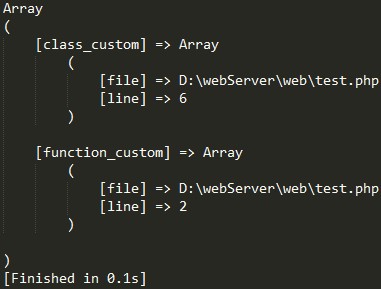php reflection application example
<?php
function custom(){
}
class custom{
public function index(){
}
}
print_r(get_define_position('custom'));
/**
* /
* @param string $name 函数名或者类名
* @return array
*/
function get_define_position($name){
$info = array();
if(class_exists($name)){
$ob = new ReflectionClass($name);
$info['class_'.$name]= array('file'=>$ob->getFileName(),'line'=>$ob->getStartLine());
}
if(function_exists($name)){
$ob = new ReflectionFunction($name);
$info['function_'.$name]= array('file'=>$ob->getFileName(),'line'=>$ob->getStartLine());
}
return $info;
}
For more articles related to PHP reflection application examples, please pay attention to the PHP Chinese website!

Hot AI Tools

Undresser.AI Undress
AI-powered app for creating realistic nude photos

AI Clothes Remover
Online AI tool for removing clothes from photos.

Undress AI Tool
Undress images for free

Clothoff.io
AI clothes remover

AI Hentai Generator
Generate AI Hentai for free.

Hot Article

Hot Tools

Notepad++7.3.1
Easy-to-use and free code editor

SublimeText3 Chinese version
Chinese version, very easy to use

Zend Studio 13.0.1
Powerful PHP integrated development environment

Dreamweaver CS6
Visual web development tools

SublimeText3 Mac version
God-level code editing software (SublimeText3)

Hot Topics
 Reflection mechanism implementation of interfaces and abstract classes in Java
May 02, 2024 pm 05:18 PM
Reflection mechanism implementation of interfaces and abstract classes in Java
May 02, 2024 pm 05:18 PM
The reflection mechanism allows programs to obtain and modify class information at runtime. It can be used to implement reflection of interfaces and abstract classes: Interface reflection: obtain the interface reflection object through Class.forName() and access its metadata (name, method and field) . Reflection of abstract classes: Similar to interfaces, you can obtain the reflection object of an abstract class and access its metadata and non-abstract methods. Practical case: The reflection mechanism can be used to implement dynamic proxies, intercepting calls to interface methods at runtime by dynamically creating proxy classes.
 How to use reflection to access private fields and methods in golang
May 03, 2024 pm 12:15 PM
How to use reflection to access private fields and methods in golang
May 03, 2024 pm 12:15 PM
You can use reflection to access private fields and methods in Go language: To access private fields: obtain the reflection value of the value through reflect.ValueOf(), then use FieldByName() to obtain the reflection value of the field, and call the String() method to print the value of the field . Call a private method: also obtain the reflection value of the value through reflect.ValueOf(), then use MethodByName() to obtain the reflection value of the method, and finally call the Call() method to execute the method. Practical case: Modify private field values and call private methods through reflection to achieve object control and unit test coverage.
 Methods to solve Java reflection exception (ReflectiveOperationException)
Aug 26, 2023 am 09:55 AM
Methods to solve Java reflection exception (ReflectiveOperationException)
Aug 26, 2023 am 09:55 AM
Methods to solve Java reflection exceptions (ReflectiveOperationException) In Java development, reflection (Reflection) is a powerful mechanism that allows programs to dynamically obtain and operate classes, objects, methods, properties, etc. at runtime. Through reflection, we can implement some flexible functions, such as dynamically creating objects, calling private methods, obtaining class annotations, etc. However, using reflection also brings some potential risks and problems, one of which is reflection anomalies (
 How to use reflection to dynamically modify variable values in golang
May 02, 2024 am 11:09 AM
How to use reflection to dynamically modify variable values in golang
May 02, 2024 am 11:09 AM
Go language reflection allows you to manipulate variable values at runtime, including modifying Boolean values, integers, floating point numbers, and strings. By getting the Value of a variable, you can call the SetBool, SetInt, SetFloat and SetString methods to modify it. For example, you can parse a JSON string into a structure and then use reflection to modify the values of the structure fields. It should be noted that the reflection operation is slow and unmodifiable fields cannot be modified. When modifying the structure field value, the related fields may not be automatically updated.
 Introduction to Golang reflection and analysis of application scenarios
Apr 03, 2024 pm 01:45 PM
Introduction to Golang reflection and analysis of application scenarios
Apr 03, 2024 pm 01:45 PM
The reflection feature in the Go language allows a program to inspect and modify the structure of a type at runtime. By using Type, Value and reflect.Kind, we can obtain the type information, field values and methods of the object, and we can also create and modify objects. Specific operation methods include: checking type (TypeOf()), obtaining field value (ValueOf(), FieldByName()), modifying field value (Set()), and creating object (New()).
 How to use reflection to create new types in golang
May 01, 2024 am 09:21 AM
How to use reflection to create new types in golang
May 01, 2024 am 09:21 AM
Using reflection, Go allows the creation of new types. 1. Use reflect.TypeOf() to get the reflect.Type value of an existing type; 2. Use reflect.New() to create a pointer value of a new type; 3. Through *Ptr.Elem( ) to access the actual value; 4. Reflection can also dynamically create new types based on strings, which is used to build flexible and dynamic programs.
 Security considerations and best solutions for golang reflection
May 04, 2024 pm 04:48 PM
Security considerations and best solutions for golang reflection
May 04, 2024 pm 04:48 PM
Reflection provides type checking and modification capabilities in Go, but it has security risks, including arbitrary code execution, type forgery, and data leakage. Best practices include limiting reflective permissions, operations, using whitelists or blacklists, validating input, and using security tools. In practice, reflection can be safely used to inspect type information.
 Using Java reflection mechanism for method overloading?
Apr 15, 2024 pm 10:54 PM
Using Java reflection mechanism for method overloading?
Apr 15, 2024 pm 10:54 PM
The reflection mechanism is used in Java to implement method overloading: Obtain methods through reflection: Use the getMethod() method to obtain the method object and specify the method name and parameter type. Calling method: Use the invoke() method to call the method, specifying the caller object and parameter values.






